List of places of worship in Sevenoaks District facts for kids
The Sevenoaks district is a part of Kent, England. It's home to almost 120 places where people have worshipped over the years. These include old Anglican churches, Victorian chapels, and newer meeting spots for different Christian denominations. You'll find many of these in the main town of Sevenoaks, as well as in smaller towns like Edenbridge, Swanley, and Westerham. Even the villages and hamlets in the countryside have their own places of worship, showing a mix of ages, building styles, and religious groups. Today, 89 places are still used for religious services, and 28 former churches and chapels have been repurposed for other uses.
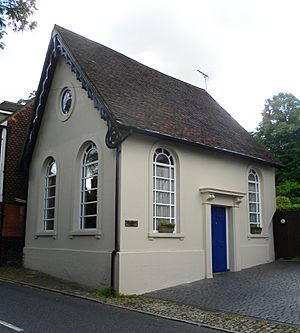
Most people in the Sevenoaks district follow Christianity. The Church of England, which is the country's official church, has nearly 50 churches here. There are also seven Roman Catholic churches. Many other Christian groups, like Baptists, Methodists, and the United Reformed Church, have several congregations. Smaller groups such as the Open Brethren, Christian Scientists, and Jehovah's Witnesses also have places of worship in the area.
Some of these buildings are very special! English Heritage has given "listed status" to 48 places of worship in Sevenoaks. This means they are protected because they have "special architectural or historic interest." There are three levels of listing:
- Grade I: For buildings that are super important and "exceptional."
- Grade II*: For buildings that are "particularly important" and more than just special.
- Grade II: For buildings that have "special interest."
As of 2001, the Sevenoaks district had 23 Grade I buildings, 85 Grade II* buildings, and 1,481 Grade II buildings.
Contents
Exploring the Sevenoaks District and Its Churches
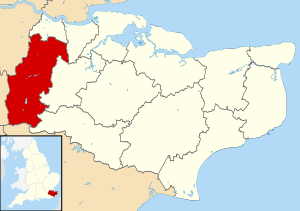
The Sevenoaks district covers about 142 square miles (368 square kilometers) of mostly countryside in western Kent. It shares borders with other areas like Dartford, Gravesham, Tonbridge and Malling, Tunbridge Wells, Wealden (in East Sussex), Tandridge (in Surrey), and the London Boroughs of Bromley and Bexley.
In 2001, about 109,305 people lived here. Sevenoaks town is the biggest place, with about 18,500 people, and it's where the local government is based. Swanley and Edenbridge are also big towns.
Sevenoaks town grew a lot during the Victorian era. The old St Nicholas parish church was joined by other churches like St Mary's at Riverhead (built 1831), St John's (1858–59), and St Mary's at Kippington (1878–80). The Roman Catholic church opened in 1896. For Nonconformists (Protestants who weren't part of the Church of England), a General Baptist chapel was built in 1842, the first Wesleyan Methodist church in 1852, a large Congregational church in 1866, and more Bible Christian and Baptist chapels in the 1880s.
Religious Beliefs in Sevenoaks
The 2001 Census showed that out of 109,305 people in Sevenoaks:
- 77.02% said they were Christian.
- 0.34% were Muslim.
- 0.2% were Hindu.
- 0.2% were Buddhist.
- 0.15% were Jewish.
- 0.09% were Sikh.
- 0.27% followed another religion.
- 14.43% said they had no religion.
- 7.3% didn't state their religion.
Compared to all of England, Sevenoaks had a higher percentage of Christians. Other religions like Islam, Hinduism, Judaism, Sikhism, and Buddhism were less common in Sevenoaks than in England as a whole.
How Churches Are Organized
Anglican Churches
Almost all Anglican churches in Sevenoaks are managed by the Diocese of Rochester, which is based at Rochester Cathedral. The only exception is St Mary Magdalene's Church at Cowden, which belongs to the Diocese of Chichester.
The Diocese of Rochester is divided into three main areas called archdeaconries: Bexley & Bromley, Rochester, and Tonbridge. These are then split into smaller areas called deaneries. For example, the church at Well Hill is in the Orpington Deanery.
Roman Catholic Churches
The seven Roman Catholic churches in the district are part of the Archdiocese of Southwark, whose main church is St George's Cathedral in Southwark, London. This archdiocese has 20 deaneries, and seven of them are in Kent. The churches in Hartley and Swanley are in the Gravesend deanery. Those in Edenbridge, Sevenoaks, and Westerham are in the Tunbridge Wells deanery.
Other Christian Groups
Many Baptist churches in southeast England are part of the South Eastern Baptist Association. West Kingsdown Baptist Church is in the North Kent Network, while Baptist churches in Bessels Green, Edenbridge, Eynsford, and Sevenoaks are in the Tonbridge Network.
As of 2010, The Drive Methodist Church in Sevenoaks, Otford Methodist Church, and Sevenoaks Weald Methodist Church were part of the Sevenoaks Methodist Circuit.
Crockenhill Baptist Church and Otford Evangelical Free Church are part of the Fellowship of Independent Evangelical Churches (FIEC) and Affinity. Westerham Evangelical Congregational Church is also connected to Affinity and the Evangelical Fellowship of Congregational Churches. Other churches, like Vine Baptist Church and Sevenoaks Town Church, are part of the Evangelical Alliance.
Dunton Green Free Church is part of the Congregational Federation. This group was formed in 1972 when some Congregational churches chose to stay independent instead of joining the United Reformed Church.
Current Places of Worship
| Name | Image | Location | Denomination/ Affiliation |
Grade | Notes |
|---|---|---|---|---|---|
| St Peter and St Paul's Church |  |
Ash | Anglican | I | This church was built in the 1300s or 1400s. It was updated in 1901–03, but its original look stayed the same. |
| Bessels Green Baptist Church |  |
Bessels Green | Baptist | II | This chapel is from the 1700s, older than the nearby Bessels House. It has a house attached to it. |
| Unitarian Meeting House |  |
Bessels Green | Unitarian | II | Built in 1716 and rebuilt in 1740, this meeting house is also from the 1700s. It has a house next to it. |
| St Martin's Church |  |
Brasted | Anglican | II* | This 1200s church was rebuilt in 1864–65 and repaired after World War II and a fire in 1989. |
| St Botolph's Church |  |
Chevening | Anglican | I | This church has Saxon roots, but most of it is from the 1200s. It has many old monuments inside. |
| St Mary's Church |  |
Chiddingstone | Anglican | II* | This church was rebuilt after a fire in 1624. It has beautiful stained glass windows. |
| St Luke's Church |  |
Chiddingstone Causeway | Anglican | II* | This church was built in 1897–98 and has a unique, short tower. |
| Chapel of the Good Shepherd |  |
Chipstead | Anglican | – | This is a small chapel used for early Sunday services. |
| St Mary Magdalene's Church |  |
Cowden | Anglican | I | This church was mostly built in the 1200s and 1300s. Its spire was damaged in World War II but has been fixed. |
| All Souls Church |  |
Crockenhill | Anglican | II | Designed in 1851, this church has no tall tower but features a clock face on its front. |
| Crockenhill Baptist Church |  |
Crockenhill | Baptist | – | This building was registered for marriages in 1879, replacing an older chapel from 1801. |
| Holy Trinity Church |  |
Crockham Hill | Anglican | II | Built in 1842, this church uses local stone. A carving inside remembers Octavia Hill. |
| Dunton Green Free Church |  |
Dunton Green | Congregational Federation | – | This church opened in 1937, replacing an older building. |
| St Peter and St Paul's Church |  |
Edenbridge | Anglican | I | This church has parts from the 1200s and 1300s. Its south chapel dates back to 1499. |
| The Eden Church | 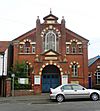 |
Edenbridge | Baptist | – | |
| St Lawrence's Church | 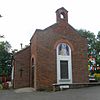 |
Edenbridge | Roman Catholic | – | This Roman Catholic church opened in 1933. Before that, people traveled to Oxted for services. |
| St Martin of Tours' Church |  |
Eynsford | Anglican | I | This church has parts from the 1100s and was restored in the Victorian era. |
| Eynsford Baptist Church |  |
Eynsford | Baptist | – | This building replaced an older Baptist church in 1907. |
| St Peter and St Paul's Church |  |
Farningham | Anglican | I | This church has a notable tower. It was extensively restored in the 1800s. |
| St Mary's Church |  |
Fawkham | Anglican | I | This small chapel has a tall, spike-like spire from the 1500s. It has a mural inside. |
| St Peter's Church |  |
Fordcombe | Anglican | II | Built in 1847-1848, this church has stained glass windows added between 1883 and 1906. |
| St Paul's Church |  |
Four Elms | Anglican | II | Built in 1880-1881, this church has a white marble altar piece from 1917. |
| St Margaret's Church |  |
Halstead | Anglican | II | The oldest part of this church is from 1855. It has monuments from the 1400s inside. |
| All Saints Church |  |
Hartley | Anglican | I | The main part of this church is from the 1100s. The old door hinges are a special feature. |
| All Saints Church Centre |  |
Hartley | Anglican | – | This is a modern building used as both a church and a hall. |
| St Francis De Sales' Church |  |
Hartley | Roman Catholic | II | This Roman Catholic church, opened in 1913, is in a protected 17th-century barn. |
| St Peter's Church | 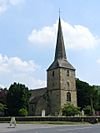 |
Hever | Anglican | I | The oldest part of this church is from the early 1200s. It was restored in 1894. |
| St Peter's Church |  |
Hextable | Anglican | – | This church started as a mission in 1905 and had an octagonal extension added in 1980. |
| Hextable Methodist Church |  |
Hextable | Methodist | – | This brick chapel was built for Methodists in 1896 for £434. |
| St Mary's Church |  |
Horton Kirby | Anglican | II* | |
| St Mary's Church |  |
Ide Hill | Anglican | II* | |
| St Mary's Church |  |
Kemsing | Anglican | II* | |
| St Mary's Church | 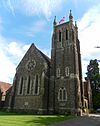 |
Kippington, Sevenoaks | Anglican | II | |
| St Katherine's Church |  |
Knockholt | Anglican | II* | |
| London Road Evangelical Church |  |
Knockholt Pound | Evangelical | – | This church was built in 1887 for Methodists and cost £981. It was sold to an Evangelical group in 1968. |
| St Mary's Church |  |
Leigh | Anglican | II* | |
| St Botolph's Church |  |
Lullingstone | Anglican | I | |
| Holy Trinity Church |  |
Markbeech | Anglican | II | |
| Kingdom Hall |  |
Marsh Green | Jehovah's Witnesses | – | This building was registered for marriages in 1999 and is used by the Oxted Congregation of Jehovah's Witnesses. |
| St John's United Reformed Church | 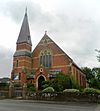 |
Marsh Green | United Reformed Church | – | This church opened in 1882. It has red and white brickwork and a corner tower. |
| Ash Chapel |  |
New Ash Green | Evangelical | – | |
| St Bartholomew's Church |  |
Otford | Anglican | I | |
| Otford Evangelical Free Church |  |
Otford | Evangelical | – | This church was registered for marriages in 1959. |
| Otford Methodist Church |  |
Otford | Methodist | – | This new church opened in 1936, replacing an older building across the street. |
| Church of the Most Holy Trinity |  |
Otford | Roman Catholic | – | Otford's Roman Catholic church was registered for marriages in 1981. |
| St John the Baptist's Church |  |
Penshurst | Anglican | I | |
| All Souls Chapel |  |
Poundsbridge | Anglican | – | This chapel was rebuilt in 1889 and is now an Anglican chapel. |
| St Peter's Church |  |
Ridley | Anglican | II* | |
| St Mary's Church |  |
Riverhead | Anglican | II | |
| St Peter and St Paul's Church |  |
Seal | Anglican | I | |
| St Lawrence's Church |  |
Seal Chart | Anglican | – | This church was designed in 1867–68, with the tower added in 1888. |
| St Nicholas' Church |  |
Sevenoaks | Anglican | II* | Most of this church dates back to the 1200s and 1400s. |
| St John the Baptist's Church |  |
Sevenoaks | Anglican | – | The west part of this church was designed in 1858. The east end was built between 1901 and 1905. |
| St Luke's Church |  |
Sevenoaks | Anglican | – | |
| The Vine Baptist Church |  |
Sevenoaks | Baptist | – | |
| Vine Evangelical Church | 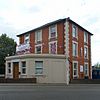 |
Sevenoaks | Brethren | – | |
| First Church of Christ, Scientist |  |
Sevenoaks | Christian Scientist | – | |
| Hope Church (Sevenoaks Town Church) |  |
Sevenoaks | Evangelical | – | |
| Kingdom Hall |  |
Sevenoaks | Jehovah's Witnesses | – | This building was originally a Baptist chapel from 1842. It became a Kingdom Hall in 1968. |
| The Drive Methodist Church | 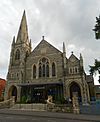 |
Sevenoaks | Methodist | – | |
| Friends Meeting House |  |
Sevenoaks | Quaker | – | This building was originally a house from the mid-1800s. Quakers bought it in 1958 and opened it as a meeting house in 1960. |
| Church of St Thomas of Canterbury | 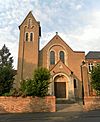 |
Sevenoaks | Roman Catholic | – | |
| Christ Church |  |
Sevenoaks | United Reformed Church | – | |
| Sevenoaks United Reformed Church | 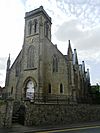 |
Sevenoaks | United Reformed Church | – | |
| St George's Church |  |
Sevenoaks Weald | Anglican | II | |
| Weald Methodist Church | 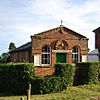 |
Sevenoaks Weald | Methodist | – | This brick building has been on the village green since 1843. |
| St Peter and St Paul's Church | 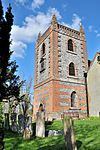 |
Shoreham | Anglican | I | |
| South Darenth Village Church | South Darenth | Non-denominational | – | ||
| Southdowns Chapel |  |
South Darenth | Non-denominational | – | |
| St Mary's Church |  |
Sundridge | Anglican | I | |
| St Mary the Virgin's Church | Swanley | Anglican | – | ||
| Swanley Full Gospel Church |  |
Swanley | Assemblies of God | – | This church was authorized for marriages in 1986. |
| Meeting Room |  |
Swanley | Brethren | – | This meeting hall was registered for marriages in 1988. |
| Elim Christian Centre |  |
Swanley | Elim Pentecostal | – | This Pentecostal church was registered for marriages in 1986. |
| Kingdom Hall |  |
Swanley | Jehovah's Witnesses | – | This Kingdom Hall is used by the London, Swanley Congregation of Jehovah's Witnesses. |
| Church of the Holy Apostles |  |
Swanley | Roman Catholic | – | This church was registered in 1965. |
| Christ Church |  |
Swanley | United Reformed Church | – | |
| St Paul's Church | 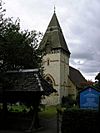 |
Swanley Village | Anglican | II | |
| Toys Hill Hall |  |
Toys Hill | Anglican | – | This building is part of the Four Elms, Hever, and Markbeech parish. |
| St Margaret's Church |  |
Underriver | Anglican | II | |
| Well Hill Mission Church |  |
Well Hill | Anglican | – | This small chapel dates from 1890. |
| St Edmund's Church |  |
West Kingsdown | Anglican | I | |
| West Kingsdown Baptist Church |  |
West Kingsdown | Baptist | – | |
| King's Church | West Kingsdown | Evangelical | – | ||
| St Bernadette's Church |  |
West Kingsdown | Roman Catholic | – | |
| St Mary the Virgin's Church |  |
Westerham | Anglican | II* | |
| Westerham Evangelical Congregational Church |  |
Westerham | Independent Congregational (EFCC) | II | |
| St John the Baptist's Church |  |
Westerham | Roman Catholic | – | This brick church opened in 1955, though work started in the 1930s. |
| St Mary the Virgin's Church |  |
Woodlands | Anglican | II | This church was built in 1851–52 in a very remote location. |
Former Places of Worship
| Name | Image | Location | Denomination/ Affiliation |
Grade | Notes |
|---|---|---|---|---|---|
| Brasted Baptist Chapel |  |
Brasted | Baptist | – | This chapel was designed in 1886 and cost £750. It stopped being used for religious services by 2003. |
| St Saviour's Church |  |
Chiddingstone Causeway | Anglican | – | Built around 1875, this building was moved and became the village hall around 1902. |
| Chipstead Chapel | 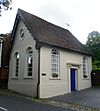 |
Chipstead | Methodist | II | Now a house, this building was a Bible Christian Church chapel. Parts of it are from the early 1600s. |
| Trinity Chapel | 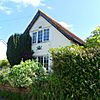 |
Cowden | Presbyterian | – | This simple brick chapel from 1894 was used until 1958 and is now a house. |
| St John the Evangelist's Church |  |
Dunton Green | Anglican | – | This church was built in 1889–90. It stopped being a church in 1987 and is now a veterinary surgery. |
| Bethel Free Church |  |
Dunton Green | Assemblies of God | – | This building was a Congregational chapel from 1873. It later became a Pentecostal church. |
| Ebenezer Chapel |  |
Edenbridge | Independent | II | Founded in 1808, this chapel is now a community center and café. |
| Four Elms Congregational Church | 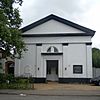 |
Four Elms | Congregational | II | |
| Goathurst Mission Chapel | Goathurst Common, Ide Hill | Anglican | – | This chapel was used from about 1895 until 1939 and is now a house. | |
| Baptist Mission Chapel | Goathurst Common, Ide Hill | Baptist | – | ||
| Hartley United Reformed Church |  |
Hartley | United Reformed Church | – | This church held its first service in 1934 but was put up for sale in 2011. |
| Hextable Bethel | Hextable | Assemblies of God | – | This building was registered for marriages in 1941. It has been used as offices for the last 10 years. | |
| Leigh Evangelical Free Church |  |
Leigh | Evangelical | II | Built in 1871, this building was also a school and is now a Royal British Legion hall. |
| St Paulinus' Church Centre |  |
Marlpit Hill, Edenbridge | Anglican | – | |
| Marsh Green Mission Church |  |
Marsh Green | Anglican | – | This church dates from around 1929 and is now a house. |
| Otford Wesleyan Chapel | 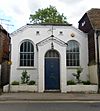 |
Otford | Methodist | – | |
| Seal Bible Christian Church | 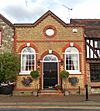 |
Seal | Methodist | – | Designed in 1881, this building is now a house. |
| Otford Lane Mission Church |  |
Sepham Heath | Anglican | – | This church was used until 1985. |
| Sevenoaks Bible Christian Chapel | 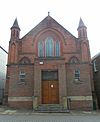 |
Sevenoaks | Methodist | – | This chapel was built in 1882. It closed in 1961 and became a Masonic lodge. |
| Sevenoaks Wesleyan Methodist Chapel |  |
Sevenoaks | Methodist | – | This building was replaced by The Drive Methodist Church. It is now a restaurant and shops. |
| Gospel Hall |  |
Sevenoaks Weald | Brethren | – | This building from 1875 is now part of a house. |
| St Edward the Confessor's Church |  |
Sevenoaks Weald | Roman Catholic | – | This church was registered for marriages in 1967 but closed in 2009. |
| Shoreham Baptist Chapel |  |
Shoreham | Baptist | – | This chapel was used from 1896 to 1982 and is now a house. |
| Penshurst United Reformed Church | 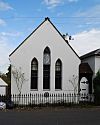 |
Smart's Hill, Penshurst | United Reformed Church | – | This chapel was built in 1866 and was used for 110 years. It is now a house. |
| Fairhaven Mission | Speed Gate, Fawkham | Non-denominational | – | This timber building was used for services until recently. It was previously a café. | |
| Wesleyan Chapel |  |
Swanley Village | Methodist | – | This building dates from 1817 and is now a house. |
| Twitton Mission Church |  |
Twitton | Anglican | – | This mission room was used from 1900 until 1982. It was extended in 1950. |
| Ruins of Maplescombe Chapel | West Kingsdown | Pre-Reformation | II |

